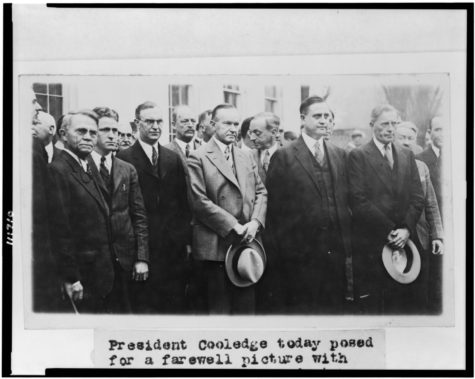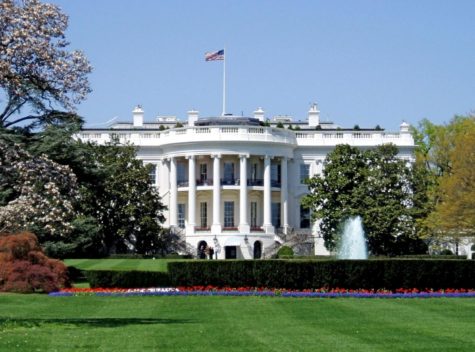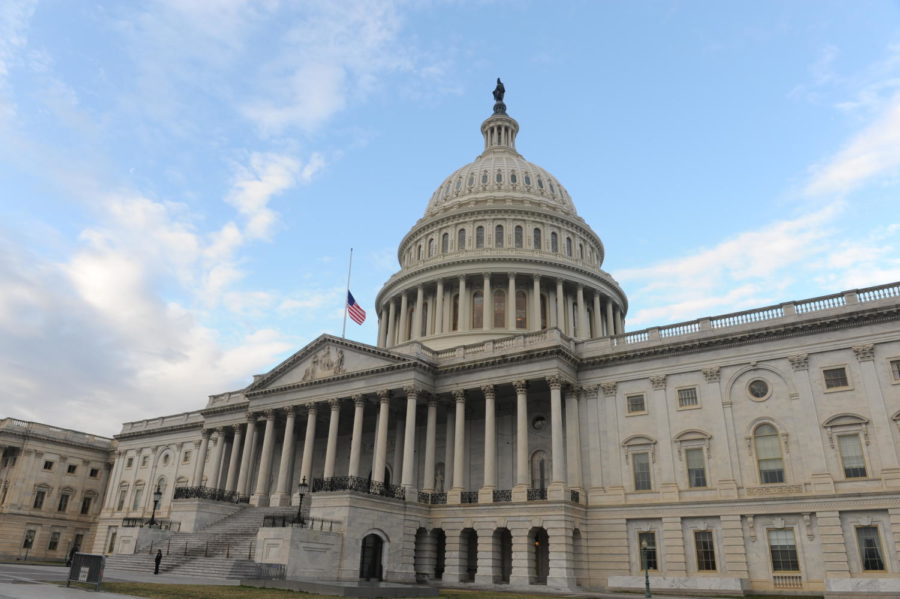Partisanship and Polarization: An Analysis of Political Journalism
As our socio-political climate becomes increasingly hyper-partisan and polarized, the intersection between politics and journalism has intensified.
Sadrulk, CC BY-SA 4.0
Political journalists thrive at the grounds in front of Capitol Hill, preparing questions, scouting senators and representatives, as well as gathering new information for their pieces.
The first political newspaper in the American colonies — Benjamin Harris’s Publick Occurrences both Foreighn and Domestick — was published in 1690. Although it immediately closed down due to lacking a license, it employed a unique form of reader participation. Articles were printed on three sheets of stationery-size paper with the fourth page left blank so that readers could add their own updates on British policies, before redistributing it to someone else. Newspapers of the time lacked objectivity. Rather, they were fiercely partisan publications that editorialized against the tyranny of the British government.
Following the American Revolution and the establishment of the United States, biased journalism continued to flourish, reaching a heightened fervor during the 1800s. The election of 1828 featured some of the most partisan reporting in America’s history. Known as the “era of dirty politics,” this time period featured incumbent President John Quincy Adams and challenger Andrew Jackson wielding the press to slander each other.
After Jackson’s victory, the public’s political zeal dwindled — and newspaper sales along with it. In 1848, the Associated Press established itself, capitalizing off the need for an objective news organization and the larger market it could serve. Several other news sources followed suit, implementing standards of impartiality. Since then, neutrality has been the core of political journalism.
However, in recent years, the pendulum has swung back to hyper-partisan reporting. Scores of fake news sources have emerged, catering to the recent rise of extremist politics in the United States. Sensationalized media has taken precedence over the truth, and the effects of this have been felt across the country.
The universe of “fake news” is larger than simply false news stories. It includes articles that may be partially true but lacking contextualization and pieces that may not include verifiable facts or sources. Meanwhile, other stories may incorporate basic verifiable facts but are written using deliberately inflammatory language that leaves out pertinent details or only presents a singular viewpoint.
The Pew Research Center reveals that many major media outlets attract partisan audiences, which in turn reflects political biases in their coverage. Motivated by business and the ability of today’s consumers to Google a quick fact, many publications have differentiated themselves by shifting from covering objective news to rhetoric and analysis.

Wall Street Journalist Kristina Peterson, who covered Congress for over ten years, stated, “The rise of more partisan blogs and social media sites has changed how polarized the country is, and that has changed politics.”
Partisan preferences for biased news make it optimal for news media to pick sides and promote bias in their reporting in favor of one candidate over another. If media bias occurs, consumers are incompletely informed of facts that are unfavorable about “their” candidate. Even if citizens are completely rational and take media bias into account, they simply cannot recover all of the missing information, which can leave voters to make decisions based on speculation and turn the election to an unfit candidate.
Nevertheless, when journalists are perceived to have a partisan bias, they risk losing their credibility and becoming seen as extensions of one political party or ideology, rather than as neutral and objective observers.
Rebecca Ballhaus, a Pulitzer Prize winner for her coverage of former President Trump’s disguised payments from Michael Cohen to Stormy Daniels and former White House correspondent for the Wall Street Journal, offered her insight. She reflected, “I think journalism gives you a really important opportunity to shape the political debate, and I think that that’s a responsibility that reporters have to take seriously.”
However, this responsibility can often be overshadowed by the inner workings of the field. The competitive nature of political journalism can also fuel the recent rise in partisan reporting. Many reporters, especially those covering politicians and controversial issues, often have to use the same sources as other reporters.
Ballhaus continued describing her experience as an investigative reporter: “You always had to assume that somebody else was onto the same story as you. I had a couple of stories where I beat somebody within minutes of them posting their version of the story, or they beat me by minutes.”
As such, smaller political news sources who do not have the resources to compete with larger organizations feel incentivized to cater a niche audience in order to increase their viewership. This particular audience more often than not falls under the category of extremist or heavily one-sided political ideologies.
By targeting this niche, smaller news sources aim to increase their viewership and establish a dedicated and loyal audience. They can achieve this by providing a unique perspective and coverage of events and issues that align with the political ideology of their target audience. This approach helps these smaller sources to differentiate themselves from larger organizations and establish their place in the crowded media landscape.
However, this drive to gain notoriety also diverts from the ethics of being a political reporter. Ethical journalism is defined as the practice of reporting news and information with impartiality, accuracy, fairness, and integrity. By their very nature, partisan news sources are biased and often prioritize the promotion of their political agenda over impartial reporting. Consequently, the dissemination of misinformation and the promotion of political agendas at the expense of fair and accurate reporting occurs.
Peterson added, “The role of a political reporter is to try and provide as much transparency around what lawmakers are doing as possible. Retaining readers’ trust is important as well as not writing your stories in a way that alienates part of the population.”
Different administrations also play a factor into the intricacies of political journalism. The most recent juxtaposition in media coverage can be found when comparing the Trump and Biden administrations.

It is no secret that Trump’s tenure was different from any other former president, but his correspondence with the media marked a significant break from the precedent set by others. In the past, presidents have typically attempted to provide accurate information to avoid undermining their credibility and political career.
However, Trump’s support was cultivated around his brand – white supremacy, wealth and greed. As long as he stayed loyal to his brand, his accuracy was not so important to his supporters. This put him in direct competition with the objective media sources covering factual information.
As a result of Trump’s media attacks, a Pew research analysis found that distrust in media sources has increased on both sides of the political spectrum from 2014 to 2020. For Republicans, distrust has increased in larger, more objective news sources such as CNN (from 33% in 2014 to 58% in 2020), The Washington Post (from 22% to 39%), and The New York Times (from 29% to 42%). Democrats are more likely to distrust smaller, more partisan news sources such as the Sean Hannity radio show (from 32% to 38%) and Breitbart News (from 7% to 36%).
Conversely, staying neutral no longer seems to be an option in our hyper-partisan world. Journalism has long operated on the basis that news stories should give equal time to opposing viewpoints – typically linked to political causes – and that a failure to do so represents a form of bias.
Yet, according to a Washington Post analysis of the media’s cutting criticism of Biden, journalists seemed “poised” from Day One of his administration to “balance” their justifiably negative coverage of Trump with a run of unjustifiably negative stories about Biden.
Large swaths of the media simply cannot or will not move beyond both-sides journalism, equating an easily targeted Democratic Party with a Republican Party that has embraced authoritarianism and voter suppression.
Media commentator and a weekly columnist for GBH News, Northeastern Professor Dan Kennedy elaborated, “Journalism should be fair, neutral and provide a voice to all sides. It should also be about determining the truth, not giving equal weight to ‘both sides.’ There was never a place for that, and we certainly don’t need it now.”
Ultimately, the relationship between journalism and politics can be best described as a delicate balance between helping influence individuals in their political and social decision-making while remaining as neutral as possible in their stance. Journalism and politics simultaneously fuel each other, leading to a never-ending cycle of hyper-partisanship and polarization in our country.
Rebecca Ballhaus reflected, “I think journalism gives you a really important opportunity to shape the political debate, and I think that that’s a responsibility that reporters have to take seriously.”
Pritika Patel is an Editor-in-Chief for ‘The Science Survey.’ She believes that journalism serves as the vital connection between people and the world...











